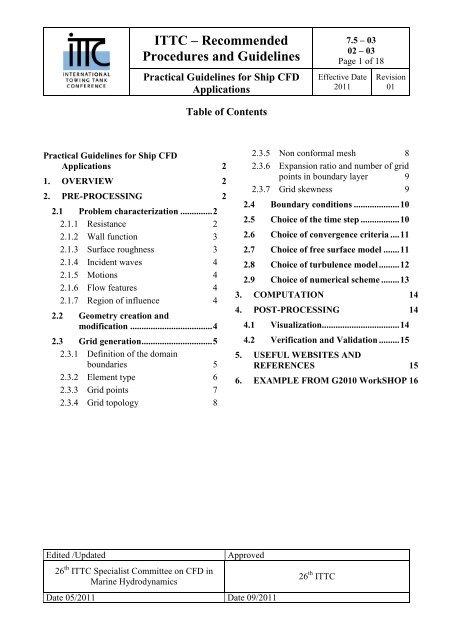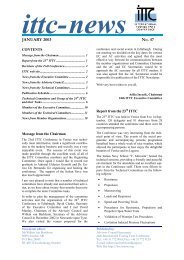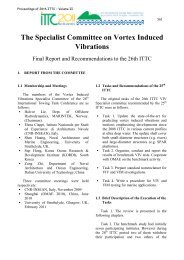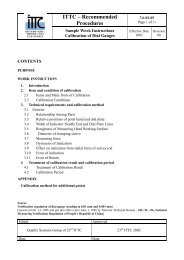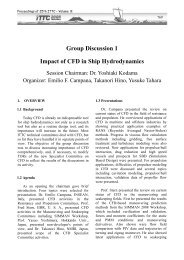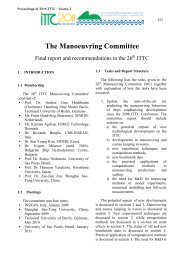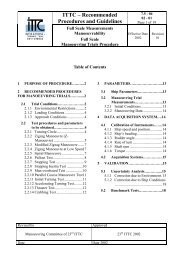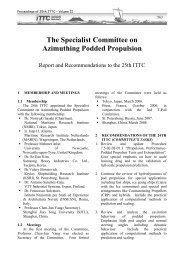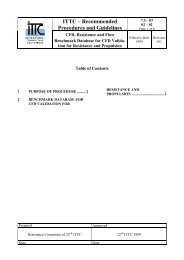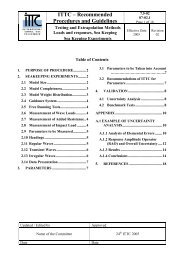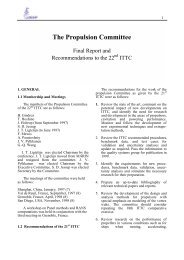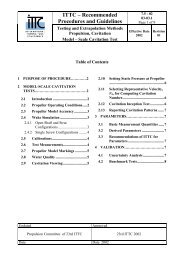Practical Guidelines for Ship CFD Applications - ITTC
Practical Guidelines for Ship CFD Applications - ITTC
Practical Guidelines for Ship CFD Applications - ITTC
You also want an ePaper? Increase the reach of your titles
YUMPU automatically turns print PDFs into web optimized ePapers that Google loves.
<strong>ITTC</strong> – RecommendedProcedures and <strong>Guidelines</strong><strong>Practical</strong> <strong>Guidelines</strong> <strong>for</strong> <strong>Ship</strong> <strong>CFD</strong><strong>Applications</strong>7.5 – 0302 – 03Page 1 of 18Effective Date2011Revision01Table of Contents<strong>Practical</strong> <strong>Guidelines</strong> <strong>for</strong> <strong>Ship</strong> <strong>CFD</strong><strong>Applications</strong>1. OVERVIEW2. PRE-PROCESSING2.1 Problem characterization .............. 22.1.1 Resistance22.1.2 Wall function32.1.3 Surface roughness32.1.4 Incident waves42.1.5 Motions42.1.6 Flow features42.1.7 Region of influence42.2 Geometry creation andmodification .................................... 42.3 Grid generation ............................... 52.3.1 Definition of the domainboundaries52.3.2 Element type62.3.3 Grid points72.3.4 Grid topology82222.3.5 Non con<strong>for</strong>mal mesh82.3.6 Expansion ratio and number of gridpoints in boundary layer 92.3.7 Grid skewness92.4 Boundary conditions .................... 102.5 Choice of the time step ................. 102.6 Choice of convergence criteria .... 112.7 Choice of free surface model ....... 112.8 Choice of turbulence model ......... 122.9 Choice of numerical scheme ........ 133. COMPUTATION4. POST-PROCESSING4.1 Visualization .................................. 144.2 Verification and Validation ......... 155. USEFUL WEBSITES ANDREFERENCES6. EXAMPLE FROM G2010 WorkSHOP 16141415Edited /Updated26 th <strong>ITTC</strong> Specialist Committee on <strong>CFD</strong> inMarine HydrodynamicsApprovedDate 05/2011 Date 09/201126 th <strong>ITTC</strong>
<strong>ITTC</strong> – RecommendedProcedures and <strong>Guidelines</strong>7.5 – 03 – 02 – 03Page 2 of 18<strong>Practical</strong> <strong>Guidelines</strong> <strong>for</strong> <strong>Ship</strong> <strong>CFD</strong>ApplicationEffective Date2011Revision01<strong>Practical</strong> <strong>Guidelines</strong> <strong>for</strong> <strong>Ship</strong> <strong>CFD</strong> <strong>Applications</strong>1. OVERVIEWThese guidelines are written assuming theuse of surface capturing methods, the methodfound in most commercial and academic <strong>CFD</strong>packages. It also assumes that the solver is gridbased,as opposed to mesh-free methods.We divide the <strong>CFD</strong> process into preprocessing,computation, and post-processingsteps. The pre-processing step involves properdefinition of the problem, grid generation andinput setup to enable running of the computationalcode. The computation requires preparingthe computer to run the problem, and running.The processing of the results of the computationto provide useful numbers and plots is calledpost-processing.2. PRE-PROCESSING2.1 Problem characterization2.1.1 ResistanceDefine the Reynolds and Froude numbers.These are given by:Re = ρ U L PP / µFr = U / gLppwhere ρ and µ are the density and viscosity ofthe fluid respectively, U is the ship speed, L PP isthe length between perpendiculars of the shipand g is the acceleration due to gravity. Notethat the viscosity of water varies with temperatureso that model scale tests carried out in waterat 10-15 ο C is different to the full scale viscosityof deep sea-water at 15 ο C.Estimate the expected free-surface wavelengthand elevations. Estimate the distance tothe wall where y +
<strong>ITTC</strong> – RecommendedProcedures and <strong>Guidelines</strong>7.5 – 03 – 02 – 03Page 3 of 18<strong>Practical</strong> <strong>Guidelines</strong> <strong>for</strong> <strong>Ship</strong> <strong>CFD</strong>ApplicationEffective Date2011Revision01an estimate of the skin friction coefficient atmid-ships.Note that in the calculation above, C Fshould be calculated using the full length of theship which in the approach gives an approximationto mean value of the local C F The <strong>ITTC</strong>model-ship correlation line should only be usedin this estimate.2.1.2 Wall functionTo resolve the high velocity gradients in theinner part of a boundary layer, strong contractionof grid nodes is required towards solid surfaces. The cells that are thus occurring close tothe wall have a high aspect ratio; typically <strong>for</strong> aship at full scale they can be 1 meter long, 0.5meter wide and only 10 -3 millimeter high. Thisnot only results in a high mesh count, but it alsoposes strong demands on the mathematics in thenumerical solution procedure. This led to theintroduction of so-called wall functions. For thelaminar flow over an infinitely long flat plat atzero pressure gradient, the well-known Blasiussolution exists, where the velocity profile isindependent of the streamwise co-ordinate,when scaled appropriately. For turbulent flowssuch solutions only exist <strong>for</strong> the innermost partof the boundary layer. This gives the possibilityto remove a significant part of the cells close tothe wall (which also have the highest aspectratio), and impose the velocity at the first gridnode adjacent to the wall (the wall function).However, wall functions are based on twodimensionalflow, typically at zero pressuregradient, and it is well known that the validityof these analytical expression becomes less, oreven disappears, with increasing adverse pressuregradients. Thus it cannot be expected thatthe wall function approach leads to reliable andaccurate solutions near a ship stern, where theflow is strongly three-dimensional and runningup against an adverse pressure gradient. Thus itis a trade-off between accuracy and computationalef<strong>for</strong>t.Wall functions should be prevented if possible,and used with care when necessary.2.1.3 Surface roughnessIn ship viscous-flow computations and evenin model testing the hull of a ship is consideredto be hydrodynamically smooth. At full scale,however, during the operation of a ship theroughness increases due to use and fouling, thusincreasing the frictional resistance. There arebasically two methods to include roughnesseffects in RANS computations. Either throughthe adaption of wall functions (when used) orthrough the adaptation of the turbulence boundaryconditions (<strong>for</strong> instance in the k-ω model).However, some major problems still remain.First the validity of the roughness model: towhat extent does the equivalent sand-grainroughness that is typically used correctly adjustthe velocity profile close to the wall? And sec-
<strong>ITTC</strong> – RecommendedProcedures and <strong>Guidelines</strong><strong>Practical</strong> <strong>Guidelines</strong> <strong>for</strong> <strong>Ship</strong> <strong>CFD</strong>Application7.5 – 03 – 02 – 03Page 4 of 18Effective Date2011Revision01ond, how can the condition of the surface of aship, sailing at any part of the world, be translatedto an equivalent sand-grain roughness?Surface roughness is still an active field ofresearch, and no general guidelines can yet begiven.2.1.4 Incident wavesDefine the wavelength, amplitude, and encounterfrequency. For irregular waves definespectrum and proper parameters. Define the cutofffrequency (highest frequency to be includedin the simulation), and determine the correspondingwavelength.2.1.5 MotionsEstimate the frequencies and amplitudes ofeach of the motions to be simulated (surge,sway, heave, roll, pitch, yaw) and the amplitudeof displacement of the ship.2.1.6 Flow featuresDefine location, size and characteristic frequencyof the flow features to be resolved (vortices,separation, flutter, etc.).2.1.7 Region of influenceEstimate the extent of the domain to besimu-lated to minimize interaction of theboundary conditions with the simulation results.2.2 Geometry creation and modificationThe geometry is generally provided as surfacedefinitions in an IGES file <strong>for</strong>mat. Alternativefile <strong>for</strong>mats may be also used provided careis taken to ensure that sufficient accuracy ismaintained during the file transfer process. Theaccuracy of the geometry should be checked toensure that the surface definitions are reasonablysmooth and connect within a given tolerance.The tolerances <strong>for</strong> the geometry should bebased on the length between perpendiculars.The required geometry tolerance also dependson the Reynolds number required <strong>for</strong> the flowcalculations.Generally, appropriate geometry tolerancesare:Scale Lpp(m) Re Tol.(m)Model 1 < L PP < 10 10 6 - 10 7 10 -5Intermediate10 < L PP < 50 10 7 - 10 8 5x10 -5Full 50 < L PP
<strong>ITTC</strong> – RecommendedProcedures and <strong>Guidelines</strong>7.5 – 03 – 02 – 03Page 5 of 18<strong>Practical</strong> <strong>Guidelines</strong> <strong>for</strong> <strong>Ship</strong> <strong>CFD</strong>ApplicationEffective Date2011Revision01surfaces. The required geometry componentsare:• Bounding surfaces of the grid domainsurrounding the geometry• Intersection curves between theappendages and the hull• Intersection curves between the hull andappendages and the vertical plane ofsymmetry• Additional curves may also be required toassist in defining key details of geometryDue consideration to the position and orientationof the origin of the geometry should betaken depending on the type of problem to besolved as <strong>for</strong>ces and moments will be obtainedabout this origin and velocity and rotation directionsdepend on the orientation. It is recommendedthat a consistent coordinate system beused within an organization. Imported CADdefinitions should then be modified to con<strong>for</strong>mto this system.2.3 Grid generationDetails on the grid generation process willlargely depend on the solver and the type ofgrids it can handle (Cartesian, structured multiblock,unstructured, overset, etc.) Here aresome general guidelines that apply to mostsolvers.2.3.1 Definition of the domain boundaries<strong>Ship</strong> viscous-flow computations typicallyhave three fixed boundaries: the ship surface,the symmetry plane and the (still) water surface.Furthermore three additional boundaries have tobe defined in order to have a closed domainaround the ship. Independent of the grid typeused these will include an inlet, an outlet and anexterior boundary, where approximate boundaryconditions have to be defined. These boundarieshave to be placed sufficiently far from the shipto minimize the effect of the location of theseboundaries on the solution. For the inlet andexterior boundary either the uni<strong>for</strong>m (undisturbed)flow is usually imposed, and in that casethe these boundaries should be located 1-2 L PPaway from the hull. Alternatively potential flowcan be imposed at these boundaries, which enablesa reduction of the domain size. At the outletin general zero gradients <strong>for</strong> all unknownsare imposed.In case free-surface boundary conditions areimposed on the water surface, the domain sizehas to be increased further. Preferably the Kelvinwedge does not intersect with the exteriorboundary, to prevent wave reflection.Unsteady methods often require a dampingzone downstream, to prevent wave reflectionfrom the outlet boundary. There the outlet has tobe placed 3-5Lpp downstream.
<strong>ITTC</strong> – RecommendedProcedures and <strong>Guidelines</strong>7.5 – 03 – 02 – 03Page 6 of 18<strong>Practical</strong> <strong>Guidelines</strong> <strong>for</strong> <strong>Ship</strong> <strong>CFD</strong>ApplicationEffective Date2011Revision012.3.2 Element typeQuadrilateral (2D, 4-sided) and hexahedral(3D, 6-sided) elements are the most popularelement types supported by almost all <strong>CFD</strong>codes. Topological attributes of these elements– presence of opposing faces, and relative locationsof cell centers and face centers – havebeen found to be beneficial to spatial accuracyof numerical solutions. In typical mappable,structured mesh-based solvers, the presence ofstencils (e.g., i, j, k coordinates in the computationaldomain) readily accommodates highorderdiscretization schemes (e.g., 5 th -orderconvection scheme) that can enhance spatialaccuracy. They are also efficient in terms ofusage of elements, since they can be clusteredand/or stretched as needed to economically resolvethe flow fields. The main downside ofthese structural mesh elements is that it is oftenvery hard to generate high-quality structuredmeshes <strong>for</strong> complex geometry.The “unstructured” mesh gives more flexibil-ityin the choice of element types, facilitatingmesh generation <strong>for</strong> complex geometry. Themajority of unstructured mesh-based <strong>CFD</strong> solversallow use of arbitrary polyhedral elementssuch as quadrilaterals (2D), triangles (2D), hexahedra,tetrahedra, wedges, pyramids, prisms,to name a few, and combination of all them(hybrid unstructured mesh). In a typical unstructuredmesh frequently adopted in ship hydrodynamics,hull boundary layer is discretizedusing a prism mesh grown out of triangularmesh on hull surface, and tetrahedral mesh isused elsewhere away from hull. Compared totypical structured meshes, meshing time can bedramatically reduced with unstructured meshes.Spatial accuracy <strong>for</strong> unstructured mesh elementssuch as triangles, tetrahedra, and pyramidscan be lower than that <strong>for</strong> quadrilateral andhexahedral elements. With unstructured meshes,one usually need a far greater number of computationalelements than structured meshes inorder to achieve a comparable accuracy. Furthermore,spatial accuracy of the majority ofunstructured mesh-based finite-volume solversis limited to 2 nd -order.Which element types to use <strong>for</strong> a givenproblem really depends on many factors such asthe solver (does your solver support unstructuredmesh?), objective of the computation (doyou need to resolve fine details of the flow?),and computer resource (do you have computersto run cases involving large meshes?). Here aregeneral guidelines in choosing mesh and elementtypes.• For relatively simple configurations suchas bare hulls, consider using a highqualityhexahedral mesh.• For relatively simple configurationsinvolving body-motion (free sinkage andtrim), consider using overset grids if your
<strong>ITTC</strong> – RecommendedProcedures and <strong>Guidelines</strong>7.5 – 03 – 02 – 03Page 7 of 18<strong>Practical</strong> <strong>Guidelines</strong> <strong>for</strong> <strong>Ship</strong> <strong>CFD</strong>ApplicationEffective Date2011Revision01<strong>CFD</strong> solver can take them and run onthem.• For complex configurations such as fullyappendedships <strong>for</strong> which a high-qualitystructured mesh is difficult to generate,consider using an unstructured mesh,preferably a hybrid unstructured mesh.• Avoid using tetrahedral mesh in boundarylayers, near free surface, and in theregions where high resolution of flowfieldsis required. Use hexahedral grids orprismatic grids instead.wavelength also depends on the order of accuracyof the numerical scheme so if 40 points arerequired <strong>for</strong> a 3 rd /4 th order method then 80points are required <strong>for</strong> a 2 nd order scheme toobtain the same accuracy (as provided by mostcommercial codes).- comment on(1) the minimum number of points per wavelength:<strong>for</strong> too short wavelength (small Froudenumber) it is probably pointless to try to catchthe small waves: the wave resistance componentis likely negligible and(2) minimum grid density to capture flow details(e.g. wake at the propeller disk) or global<strong>for</strong>ces (i.e. total resistance)2.3.3 Grid pointsGrid points distributions are determined withconsideration of the following points.- Based on the availability of computer timeand power, determine the size (total number ofgrid points) of the grid as well as the grid sizerequired <strong>for</strong> previous similar problems. Thisshould determine if sufficient resources areavailable to obtain reliable results.- Design the grid blocks in such a way thatthey will be properly decomposed <strong>for</strong> efficientcomputation, avoiding the use of too manysmall blocks.- Use no less than 40 grid points per wavelengthon the free surface. In irregular wavesuse at least 20 grid points <strong>for</strong> the shortest wavelength to resolve. The number of grid points per- Use no less than 20 grid points in the verticaldirection where the free surface is expected- Whenever possible use orthogonal grids toresolve a free surface- For turbulence models integrating to thewall (Spalart-Allmaras, k-ω, etc.) locate the firstgrid point at a distance from the ship’s wallsuch that y + = 1. If wall functions are used thisdistance can increase such that 30 < y + < 300 ,depending on the wall function implementation.- Whenever possible use hyperbolic grid generatorsto guarantee as much as possible anorthogonal grid near the wall.- Grids orthogonal to the domain boundaries,where the boundary conditions are imposed, arerecommended. For some boundary conditions,such as symmetry conditions and wall condi-
<strong>ITTC</strong> – RecommendedProcedures and <strong>Guidelines</strong>7.5 – 03 – 02 – 03Page 8 of 18<strong>Practical</strong> <strong>Guidelines</strong> <strong>for</strong> <strong>Ship</strong> <strong>CFD</strong>ApplicationEffective Date2011Revision01tions this orthogonality condition may be mandatory<strong>for</strong> some solvers.- Provide refinement where flow features ofinterest are expected, in accordance with thesize of the feature to be simulated. Where theflow features of interest are not known be<strong>for</strong>ehand,it is necessary to use an iterative processto establish the existence of the key flow featuresof a given geometry. This requires an initialflow solution to be obtained and examinedand subsequent grid refinement provided aroundthe flow features. This should be carried outuntil some measure of grid refinement index issatisfied to ensure that flow features are sufficientlyresolved.- If overset grids are used, check that overlapis sufficient <strong>for</strong> the number of fringes that areneeded in your code and order of accuracy.- Ensure sufficient resolution of high curvaturegeometry is provided, especially aroundleading and trailing edges. An appropriate gridstructure can enable more efficient use of computingresources but at the expense of increasedgrid generation time and complexity.- Check the grid quality to guarantee that allvolumes are positive (positive Jacobian in structuredgrids), skewness and aspect ratio are acceptable,and that orthogonality is nearly satisfiedin most places.2.3.4 Grid topologyGrid topology is the mapping relation betweenthe grid surface in physical (x, y, z) spaceand the computational (i, j, k) space in case ofstructured grid systems. In the single block gridaround a ship hull, O-O or H-O topology isadopted in most cases, although C-O and H-Hgrids can be applied. In either topology, the gridlines in the girth-direction are O-type. The longitudinalgrid lines in O-O grids wrap around aship hull whereas those in H-O grids start fromthe inflow boundary and go through regionsahead of a ship, side of a hull and aft of a ship.Thus, when the total number of grid points andthe number of grid points along the lines in thenormal and in the girth directions are fixed, O-Ogrids can accommodate more grid points alonga ship hull than H-O grids. Also, O-O grids canbe adapted more easily to a blunt bow or a widetransom sterns which are typical in moderncommercial ships. On the other hand, since thegrid lines in the normal directions spread to theouter boundary in O-O grids, the grid resolutionin the wake region and the region away from ahull tends to be lower than the H-O grids.There<strong>for</strong>e choice of grid topologies should bebased on the nature of ship hull geometry andon the consideration of which part or whichfeature of flow fields is more important thanothers.2.3.5 Non con<strong>for</strong>mal meshNon con<strong>for</strong>mal grids may be required <strong>for</strong>highly complex geometries. This occurs whenthe level of detail of the geometry is increasedand as more geometric entities such as propul-
<strong>ITTC</strong> – RecommendedProcedures and <strong>Guidelines</strong>7.5 – 03 – 02 – 03Page 9 of 18<strong>Practical</strong> <strong>Guidelines</strong> <strong>for</strong> <strong>Ship</strong> <strong>CFD</strong>ApplicationEffective Date2011Revision01sion shaft and bracket arrangements and bilgekeel and roll stabilization systems are includedin the geometry definition. These types of geometriesare often required <strong>for</strong> wake flowanalysis where it is important to capture smallflow features. For these types of grids a noncon<strong>for</strong>malgrid may be more appropriate whereparts of the total grid do not fully connect. Forthese grids the flow solution algorithm must usespecial coding in order to interpolate betweenthe non-connected grids. For some methods thisinterpolation scheme may be defined by ‘interfaces’where the interpolation method is definedacross grid boundary surfaces, <strong>for</strong> other methodsthe interpolation scheme is defined by‘overlaps’ where the interpolation is definedacross local grid volumes. For both of thesetypes of interpolation schemes the <strong>for</strong>mal orderof accuracy is likely to be reduced, especiallywhen there are large differences between thegrid resolution and topology. However, this typeof approach can be used to considerably simplifythe grid generation process so that locallybetter quality grids can be produced around thevarious geometry components and assembledtogether to <strong>for</strong>m a complete grid using the interpolationschemes.Non con<strong>for</strong>mal grids should be used withcare, <strong>for</strong> example, <strong>for</strong> free-surface flows undesira-blewave reflections can occur at the interfacesor overlap if the interpolation scheme isunable to resolve the change in grid correctly.This can be alleviated by ensuring that the localchange in the grid across the non con<strong>for</strong>malregion is minimized with similar grid resolutionand spacing used <strong>for</strong> both grid regions. Noncon-<strong>for</strong>mal grids can also use different types toassist the grid generation process, <strong>for</strong> example agrid <strong>for</strong> a detailed rudder with skeg and endplates can be produced using a localprism/tetrahedral grid which is embedded insidea multiblock grid <strong>for</strong> the hull.2.3.6 Expansion ratio and number of gridpoints in boundary layerThe number of points within the boundarylayer is determined by the level of accuracyrequired and the turbulence model chosen. Anear wall turbulence model resolving the laminarsub-layer needs at least 3 points inside it,which <strong>for</strong> a y+=2 results in an expansion ratioof 1.5, the largest acceptable. In most cases ay+=1 will be used with expansion ratios around1.2. Wall functions start farther out in regions ofsmaller velocity gradients and can use largeexpansion ratios, as large as 1.5 <strong>for</strong> coarse grids.In fine grids integrating all the way to the wallthe total number of points within the boundarylayer can be very large, on the order of 100,while <strong>for</strong> coarse grids with wall functions lessthan 10 will suffice.2.3.7 Grid skewnessTypically the 3x3 determinant <strong>for</strong> structuredgrids should be greater than 0.3, as a measure of
<strong>ITTC</strong> – RecommendedProcedures and <strong>Guidelines</strong>7.5 – 03 – 02 – 03Page 10 of 18<strong>Practical</strong> <strong>Guidelines</strong> <strong>for</strong> <strong>Ship</strong> <strong>CFD</strong>ApplicationEffective Date2011Revision01the Jacobian and associated skewness. However,it may be necessary to have a few small cellswhere the 3x3 determinant is no better than 0.15.For these cases it may be necessary to use asmaller time step or increased under-relaxationin order to achieve converged results.2.4 Boundary conditionsChoose boundary conditions that are compatiblewith the domain size chosen and problemapproximations.- Inlet conditions that are far from the fieldcan impose pressure, velocity and free surfaceelevation as Dirichlet boundary conditions mimickingfree flow. If the boundary is close tothe ship Neumann boundary conditions (zeronormal gradients) need to be imposed to relaxthe pressure and free surface.- Far field boundary conditions can also befree flow if the boundary is far from the object(typically one ship length <strong>for</strong> Froude numberslarger than 0.2). If the boundary conditions areclose or the Froude number is small then theship will affect significantly the flow on theboundary, and Neumann conditions are preferred.- Exit conditions usually are modeled withzero second derivative <strong>for</strong> velocities (zero traction)and zero gradient <strong>for</strong> pressure and freesurface. This condition requires no inflow fromthis boundary, so it must be placed far downstreamenough to guarantee this throughout thecomputation. Otherwise zero normal gradientconditions can be attempted.- The bottom can be treated as a far field ifdeep water is being simulated.Sides and bottom may need to be treated asmoving boundaries if shallow waters or a narrowtowing tank are being simulated.- In case of free surface flow simulations, theso-called radiation conditions must be imposedon exit or far field boundaries in order to preventwave reflection on boundaries. Simple wayto implement no reflection condition is to dampwaves which go through boundaries with numericaldissipation by use of large grid spacenear the boundaries or by explicitly adding artificaldamping terms to the governing equations.This is often called ‘numerical beach‘ approach.2.5 Choice of the time stepIn explicit solvers the time step is chosen tosatisfy the CFL condition or to resolve the flowfeatures of interest, whatever results smaller.Usually the CFL condition is more demandingthan the flow requirements. In implicit solversthe time step is decided by the flow features. Asa rule of thumb:- For waves, use at least 60 time steps per period<strong>for</strong> the shortest waves, or 100 time stepsper period <strong>for</strong> regular waves.- For other periodic phenomena (roll decay,vortex shedding, etc.) use at least 100 time stepsper period.
<strong>ITTC</strong> – RecommendedProcedures and <strong>Guidelines</strong>7.5 – 03 – 02 – 03Page 11 of 18<strong>Practical</strong> <strong>Guidelines</strong> <strong>for</strong> <strong>Ship</strong> <strong>CFD</strong>ApplicationEffective Date2011Revision01- For complex unsteady phenomena, likewetted transom instabilities, use at least 20 timesteps per period <strong>for</strong> the highest frequency to beresolved.- For rotating propellers use at least 200 timesteps per revolution.- For standard pseudo-transient resistancecomputations, use ∆t = 0.005 ~ 0.01 L/U. Thechoice of time step will also depend on thecomplexity of the turbulence model. For Reynoldsstress turbulence models it is more appropriateto use ∆t = 0.001 ~ 0.0025 L/U. This alsorequires a larger number of iterations to obtainreasonable convergence. In more unstable problems,as those with low Froude number, asmaller time step may be needed. Notice thatnaturally transient problems will not reach asteady-state solution.2.6 Choice of convergence criteriaA number of convergence criteria should bedefined and examined in order to ensure reliableconvergence of solution.At first hand the level of convergence shouldbe assessed by the history of residual variations<strong>for</strong> the mass and momentum equations. Residualsindicate how far the present approximatesolution is away from perfect conservation (balance)of mass and momentum. Thus the residual<strong>for</strong> a discretized equation is defined as the L 1 -Norm of the imbalance between the left and theright hand side of that equation over all thecomputational cells. Usually in definition theresidual is also scaled by a reference value.Sometimes L 2 -Norm and L ∞ -Norm are also usedto define residual.<strong>CFD</strong> users do not need to worry about thedefinition of residuals, as they are often predefinedby code developers. Instead, attentionshould be paid to the selection of convergencecriteria. The recommended criterion is “the dropof scaled residuals by at least three orders ofmagnitude off their initial values”. However ifthis criterion cannot be achieved due to complexityof the problem or oscillatory convergenceis found, then other criteria can be used toassess the convergence of the globally integratedparameters, <strong>for</strong> example:- Forces and moments acting on the hull- Thrust and torque produced by the propulsionsystem- Velocity and turbulence parameters in keyregion of the flow field (e.g. at propeller plane<strong>for</strong> nominal wake calculations)2.7 Choice of free surface modelThere are two major categories in free surfacemodels. First one is an interface fitting approachin which a numerical grid is aligned tode<strong>for</strong>med free surface shape and the other is aninterface capturing approach in which a freesurface shape is defined as an iso-surface of amarker function and a grid does not to fit to afree surface. Choice of a free surface model is
<strong>ITTC</strong> – RecommendedProcedures and <strong>Guidelines</strong>7.5 – 03 – 02 – 03Page 12 of 18<strong>Practical</strong> <strong>Guidelines</strong> <strong>for</strong> <strong>Ship</strong> <strong>CFD</strong>ApplicationEffective Date2011Revision01needed when a flow solver used offer both interfacefitting and capturing models.The interface fitting approach is more accurateand efficient than the capturing approach,since free surface boundary conditions can beapplied in the exact free surface location. There<strong>for</strong>ethe interface fitting model may be selectedwhenever it is possible. However, it should benoted that re-gridding procedure is essential inthe interface fitting method in order to keep thegridlines follow the de<strong>for</strong>mation of free surface.This may cause severe distortion of gridlineseven though the initial grid fitting to an undisturbedfree surface has a good quality.Difficulties in grid generation and/of regriddingcan be avoided in interface capturingapproaches. Also, in the case that large de<strong>for</strong>mationof free surface, such as overturning orbreaking waves, is expected, interface capturingmethods should be used. Since the capturingmethods demand finer grid resolutions in theinterface zones, grid generation requires moreattentions. Choice of the level-set functionmethod and volume-of-fluid method in the capturingapproaches is little impact in the finalsolutions. Although details of numerical proceduresare different from each other, wellexaminedflow solvers provide similar results inboth models.2.8 Choice of turbulence modelTurbulence modelling has been an importantresearch topic over the last decades. A largenumber of models have been proposed, testedand applied, but no ‘universal’ model has beendeveloped. Thus one is <strong>for</strong>ced to choose the bestmodel available <strong>for</strong> each specific application.The majority of turbulence models is based onthe so-called Boussinesq hypothesis, which definesa turbulence or eddy viscosity (as opposedto the molecular viscosity) to account <strong>for</strong> theeffect the turbulence motion has on the meanflow.Zero-equation, or algebraic models expressthe eddy viscosity in terms of the mean flowvariables and mean flow gradients without solvingany additional equations. They are hardlyever used in ship hydrodynamics.One-equation models solve one additionalequation (i.e. in addition to the momentum andmass conservation equations) <strong>for</strong> the eddy viscosity.Regularly encountered in ship hydrodynamicsare models by Menter and by Spalart-Allmaras. These models are sometimes extendedwith a correction <strong>for</strong> vortical flow, toimprove wake field predictions.Two-equation models solve two additionalequations <strong>for</strong> the eddy viscosity, one <strong>for</strong> theturbulence kinetic energy (k), and one <strong>for</strong> itsdissipation rate (typically ε or ω). These modelshave shown to be able to give accurate predic-
<strong>ITTC</strong> – RecommendedProcedures and <strong>Guidelines</strong>7.5 – 03 – 02 – 03Page 13 of 18<strong>Practical</strong> <strong>Guidelines</strong> <strong>for</strong> <strong>Ship</strong> <strong>CFD</strong>ApplicationEffective Date2011Revision01tions in ship hydrodynamics, especially certainversions of the k-ω model and are by far themost applied ones (80% of the submissions <strong>for</strong>the Gothenburg 2010 Workshop).An important class of turbulence models, notbased on the Boussinesq hypothesis, arethe Reynolds-stress models, and versionsthereof. Rather than introducing an eddyviscosity,they aim to solve the equations <strong>for</strong> thesix Reynolds stress components directly. Apartfrom that, additional equations have to besolved, since terms in these equations requiremodelling as well. Consequently Reynoldsstressmodels are more computationally intensive,and often less easy to converge, comparedto the one or two-equation models. However,they contain more physics and can be expectedto be more accurate than eddy-viscosity models.A more recent development is Large EddySimulation (LES). Other than the turbulencemodels discussed above it does not average theNavier-Stokes equations in time, but filtersthem in space. This results in transient computationson extremely dense grids as they aim toresolve all turbulence motion to a very smallscale. Detached Eddy Simulation (DES) is ahybrid method that tries to reduce the requiredcomputational ef<strong>for</strong>t by solving the (unsteady)RANS equation in the boundary layer and applyingLES in the rest of the domain. However,the very high Reynolds numbers encountered inship hydrodynamics prevents the application ofboth methods in practical design projects.2.9 Choice of numerical schemeIn the majority of industrial <strong>CFD</strong> codes, diffusionterms in the governing equations are discretizedusing a second-order (central differencing)scheme by default. Thus, spatial accuracyis largely determined by discretizationscheme used <strong>for</strong> convection terms.The first-order upwind (FOU) scheme, offeredin many commercial <strong>CFD</strong> codes often as adefault scheme, is famously stable. However, itintroduces an unacceptably large amount ofnumerical (false) diffusion - that is why it is sostable. There<strong>for</strong>e, it should be avoided at allcosts. However, the very robustness of the FOUscheme can be exploited to start up the solution.For example, the first 100 iterations (or timesteps) during which the solution is most susceptibleto numerical instability and divergence)can be run using the FOU. As the flow-fieldsstart settling down, one can switch to a highorderscheme.The majority of high-order convection discretizationschemes in popular use today <strong>for</strong>mallyhave a second-order of accuracy with anupwind bias. All these second-order upwind(SOU) schemes differ from one another in termsof the flux limiter used to suppress unphysicaloscillations in the solutions. Still higher-order
<strong>ITTC</strong> – RecommendedProcedures and <strong>Guidelines</strong>7.5 – 03 – 02 – 03Page 14 of 18<strong>Practical</strong> <strong>Guidelines</strong> <strong>for</strong> <strong>Ship</strong> <strong>CFD</strong>ApplicationEffective Date2011Revision01schemes such as 5 th -order scheme exist. However,not all <strong>CFD</strong> solvers offer such higherorderschemes. Even if they are available, thelack of robustness often makes them less usefulthan claimed. The SOU scheme that is both reasonablyaccurate and robust, and <strong>for</strong> that reasonis an industrial workhorse <strong>for</strong> convection discretization.The SOU scheme is there<strong>for</strong>e recommended<strong>for</strong> all convection-diffusion type oftransport equations.Volume-fraction equation requires a specialcare, inasmuch as the transported quantity isessentially a step function in the vicinity of freesurface, and the traditional convection schemesdesigned <strong>for</strong> convection-diffusion equationsper<strong>for</strong>m poorly in transporting the step-function.It has been found that convection schemes withsome degree of downwind bias resolve thesharp interface much better.Second-order central differencing (CD)scheme is often used in large eddy simulation(LES) and direct numerical simulation (DNS) infavor of its low-dissipation that is critical toaccurately resolve turbulent structures. However,CD scheme is inherently unstable, givingtroubles <strong>for</strong> cases involving fine meshes andsmall effective viscosity (large cell Reynoldsnumber). One should consider using a stabilized<strong>for</strong>m of central differencing.3. COMPUTATIONAt runtime, a few decisions need to be made:a) In modern computers, choose the numberof processors so that you use 50,000 to 200,000grid points per processor.b) To maximize per<strong>for</strong>mance, try to distributethe load evenly between nodes. For instance,if running in a Linux cluster with 2 dualcoreprocessors (4 cores) per node, and yourcase needs 6 cores, you can distribute your loadin two nodes using 4-2 or 3-3 configurations.The second balances the load per node better.c) Modern workstations with shared memoryare available with up to 48 processors, thoughmuch larger specialized systems are produced.High-per<strong>for</strong>mance clusters are typically cheaperper processor <strong>for</strong> large systems (thousands ofcores) but use distributed memory. Sharedmemorysystems allow all processors access allmemory, resulting in easier programming andbetter scalability of most applications. On theother hand, distributed memory systems providemassive number of processors <strong>for</strong> very largecomputations.4. POST-PROCESSING4.1 VisualizationA number of post processing plots should beused as a minimum sub-set of in<strong>for</strong>mation toensure that the correct settings have been used
<strong>ITTC</strong> – RecommendedProcedures and <strong>Guidelines</strong>7.5 – 03 – 02 – 03Page 15 of 18<strong>Practical</strong> <strong>Guidelines</strong> <strong>for</strong> <strong>Ship</strong> <strong>CFD</strong>ApplicationEffective Date2011Revision01<strong>for</strong> each computation. This should include thefollowing:- Contour plots of the pressure coefficient,skin friction coefficient and y + of the geometrysurface- Contour plots of the boundary layer profilesalong the hull geometry- Contour and vector plots of the nominal orpowered wake upstream of the plane of the propulsor(Care should be taken to ensure that thisplane does not lie within the propulsiondisc/volume)Reasonable checks should be carried out toensure that these plots are smooth and continuous.In particular, regions of specially bad gridquality should be evaluated to check if thesolver can handle properly less than optimalgrids without causing unphysical artifacts.4.2 Verification and ValidationThe <strong>ITTC</strong> procedure 7.5-03-01-01 alreadyprovides “methodology and procedures <strong>for</strong> estimatingthe uncertainty in a simulation result”.5. USEFUL WEBSITES AND REFER-ENCES1. MARNET-<strong>CFD</strong> Best Practice <strong>Guidelines</strong><strong>for</strong> Marine <strong>Applications</strong> of <strong>CFD</strong>(https://pronet.wsatkins.co.uk/marnet/guidelines/guide.html )2. ERCOFTAC Best Practice <strong>Guidelines</strong>.(http://www.ercoftac.org/index.php?id=77)3. http://www.cfd-online.com/Wiki/Best_practise_guidelines4. http://www.cfd-online.com/Links/onlinedocs.html#bestpractice5. http://www.nafems.org/resources/cfd_guidance/6. <strong>ITTC</strong>, 1999, “Uncertainty analysis in <strong>CFD</strong>,Verification and Validation Methodologyand Procedures”, No. 7.5-03-01-01.7. <strong>ITTC</strong>, 1999, “Uncertainty analysis in <strong>CFD</strong>,<strong>Guidelines</strong> <strong>for</strong> RANS codes”, No. 7.5-03-01-02.8. <strong>ITTC</strong>, 1999, “<strong>CFD</strong> User’s Guide”, No. 7.5-03-01-03.9. <strong>ITTC</strong>, 1999, “<strong>CFD</strong> Verification”, No. 7.5-03-01-04.10. Eca L. Vaz G. and Hoekstra M., 2010.“Code Verification, Solution Verificationand Validation In RANS Solvers”, Proc. ofASME 2010 29 th Intl Conference on Ocean,Offshore and Arctic Engineering, China.11. Tao X. and Stern F., 2010, “Factors of Safety<strong>for</strong> Richardson Extrapolation”, Journal ofFluids Engineering, Vol. 132, 061403.12. ASME Committee PTC-61, 2009, ANSIStandard V&V 20. ASME Guide on Verificationand Validation in Computational FluidDynamics and Heat Transfer.13. Eca L. and Hoekstra M., 2008: "TestingUncertainty Estimation and Validation Proceduresin the Flow around a Backward FacingStep", 3 rd Workshop on <strong>CFD</strong> UncertaintyAnalysis, Lisbon.
<strong>ITTC</strong> – RecommendedProcedures and <strong>Guidelines</strong>7.5 – 03 – 02 – 03Page 16 of 18<strong>Practical</strong> <strong>Guidelines</strong> <strong>for</strong> <strong>Ship</strong> <strong>CFD</strong>ApplicationEffective Date2011Revision0114. Eca Luis and Hoekstra Martin, 2006: “DiscretizationUncertainty Estimation based onLeast Squares version of the Grid ConvergenceIndex”, 2 nd Workshop on <strong>CFD</strong> UncertaintyAnalysis, Lisbon.15. Eca L. and Hoekstra M., 2002: "An Evaluationof Verification Procedures <strong>for</strong> <strong>CFD</strong><strong>Applications</strong>”, Proceedings of the 24 th Symposiumon Naval Hydrodynamics, Japan.16. Stern F. et al. 2001, “Comprehensive Approachto Verification and Validation of<strong>CFD</strong> Simulations Part 1: Methodology andProcedures”, Journal of Fluids Engineering,Vol. 123, December.17. AIAA (1988), “AIAA guide <strong>for</strong> the verificationand validation of computational fluiddynamics simulations”, AIAA G-077-1998.18. Rizzi, A. & Voss, J. (1998), “Towards establishingcredibility in computational fluiddynamics simulations”, AIAA Journal, vol.36, no. 5, pp. 668-675.19. Roache, P.J. (1998), “Verification and validationin computational science and engineering”,Hermosa Publishers, Alberquerque.6. EXAMPLE FROM G2010 WORK-SHOPAn example of the application of theseguidelines is illustrated by one of the Gothenburg2010 (G2010) workshop test cases. Theexample chosen was Test Case 2.1, the KCShull <strong>for</strong>m without rudder and calm water conditionswith zero sinkage and trim. The Reynoldsnumber was defined as Re = 1.4x10 7 and theFroude number defined as Fr = 0.26. The lengthof the hull Lpp was defined as 230.0 m at fullscale with a scale ratio of λ = 31.6 <strong>for</strong> the modelscale measurements.The Froude number defines the free streamspeed ofU = Fr g(Lpp/λ) =0.26*(9.81 ∗ 230/31.6)= 2.196 m/s.The wavelength, λ W corresponding to thisFroude number <strong>for</strong> the model scale geometry isgiven by:λ W =2π( L pp /λ) Fr 2 = 2π*(230/31.6)*0.26 2= 3.0915 m.The Reynolds number definesC F = 0.075/(log 10 Re-2) 2= 0.075/ (log 10 (1.4x10 7 )-2) 2 = 0.002832and <strong>for</strong> y + =1 the first cell heighty =y + (L pp /λ) /(Re(Cf/2)= (230/31.6)/(1.4x10 7 (0.002832/2))= 1.3816x10 -5 m.Other first cell heights simply scale the distance<strong>for</strong> y + =1 so y + =30 isy=30*1.3816x10 -5 m.Checks of the geometry file provided as anIGES file showed that the geometry was builtwith a suitable tolerance.
<strong>ITTC</strong> – RecommendedProcedures and <strong>Guidelines</strong>7.5 – 03 – 02 – 03Page 17 of 18<strong>Practical</strong> <strong>Guidelines</strong> <strong>for</strong> <strong>Ship</strong> <strong>CFD</strong>ApplicationEffective Date2011Revision01The domain sizes chosen <strong>for</strong> the majority ofthe flow calculations carried out <strong>for</strong> the G2010Test Cases 2.1 workshop had an upstreamboundary of approximately 1 L pp from the bow,a downstream boundary of approximately 2 L ppfrom the stern, a side boundary 1 L pp from theplane of symmetry and a bottom boundary of 1L pp from the keel. A number of different positionswere used <strong>for</strong> the top boundary, somemethods computed the air flow above the shiphull and had a boundary of up to 0.5-1 L pp fromthe keel and other contributors defined the topboundary at the deck at 0.025 L pp . The choice oftop boundary position was dependent on detailsof the chosen boundary condition.Another variant on the domain size was tochoose to match the width and depth of the domainto the width and depth of the towing tankin which the model scale hull was measured.This is appropriate <strong>for</strong> validation cases wheredetailed comparison with measurements is required.The majority of contributions to the G2010workshop Test case 2.1 used hexahedral cellswith expansion ratios between 1.2 and 1.5 in theboundary layer. A number of techniques wereused to create the hexahedral cells, some usedsingle block methods, some multi-block methodsand other overset and Cartesian cell methodsso most of the techniques that are describedin these guidelines were used. In addition, somecontributors used unstructured prism and tetrahedralcells.The number of cells per wavelength of atleast 40 points per wavelength requires a maximumspacing in the axial direction of 3.0915/40= 0.07728 m. All contributors used at least thisnumber of points in the axial direction on theship hull except where coarse grids were defined<strong>for</strong> grid resolution studies.Most contributors used a VoF method to definethe free surface wave pattern.Nearly all contributors used a variant of thek-ω turbulence model with some contributorsusing Reynolds stress models in addition to thetwo equation model. Some contributors usedwall functions, with some modifications to account<strong>for</strong> pressure gradients but most used nearwall boundary conditions with y + =1.Second order accurate numerical schemeswere used <strong>for</strong> this test case with some contributorsusing higher order methods. Most contributorsused a special scheme <strong>for</strong> the VoF toimprove the free surface capturing.A range of different computational resourceswere used <strong>for</strong> these cases, from workstations tolarge scale supercomputers, but the majority ofcontributors used some <strong>for</strong>m of parallelprocessing techniques to reduce the elapsedtime <strong>for</strong> the computations.
<strong>ITTC</strong> – RecommendedProcedures and <strong>Guidelines</strong>7.5 – 03 – 02 – 03Page 18 of 18<strong>Practical</strong> <strong>Guidelines</strong> <strong>for</strong> <strong>Ship</strong> <strong>CFD</strong>ApplicationEffective Date2011Revision01Convergence criteria of at least three ordersof magnitude reduction in the residuals wereused by all contributors.Contour plots of the wave patterns and longitudinalplots of the wave profile at a number ofpositions were produced by every contributorand compared with the measured data.


